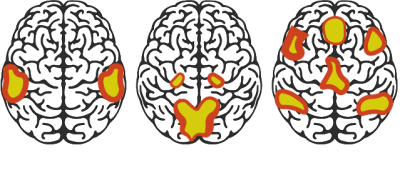The Default Mode Network is a matrix of widely separated areas of the brain which behave as a single unit in order to create the state of introspection from which creativity arises. At the core of human creativity lies interactions between these diverse constituents of the Default Mode Network.
Once the Default Mode Network has understood the creative requirement, it will search for an answer whilst you are able to concentrate your mind on other things – such as taking a bath in the case of Aristotle and his claimed Eureka moment.
 What Creates Creativity in that Brain?
What Creates Creativity in that Brain?
The brain consists of multiple functioning units which are connected together in different networks to perform different tasks.
The task positive networks (TPNs) are bilateral groups of areas in the cerebral cortex that collectively increase their activity when participants engage in demanding non–self-referential tasks. Within the grouping, dubbed the TPNs, are the Auditory and Visual Networks, and the Salience and Executive Control Networks.
The following Diagram shows connected areas of the brain involved in Auditory, Visual, and Executive Control Tasks:

 The Default Mode Network (DMN)
The Default Mode Network (DMN)
Whereas these Task-orientated networks increase their activity during the performance of a task, a remarkably consistent set of brain areas reduce their activity at the same time. These widely separated areas of the cerebral cortex behave as a single unit, and are collectively known as the Default Mode Network.
There is an anti-correlation relationship between the default mode network and other brain systems, that is to say that when other systems operate the default mode network reduces its activity.
Human Creativity is a result of the collective actions of this Default Mode Network.
Such a Default Mode Network (DMN) has been found in other spaces including chimpanzees, monkeys, rats and mice. In other words, creativity is also exhibited by other species of animals.
The following diagram shows connected areas of the brain that make up the Default Mode Network in humans:

 What is the function of the Default Mode Network?
What is the function of the Default Mode Network?
One function of the Default Mode Network (DMN), and perhaps its main function, is one of introspection, variably called mind wandering, daydreaming, musing, stimulus-independent thought, or undirected thought. But perhaps this should be more accurately described as the experience of the DMN’s function. The function of this activity, reflected in these experiences, is to act as a “prospective brain . . . to imagine, simulate and predict possible future events. In this sense, the DMN is the waking brain’s equivalent of the dreaming brain”.
Both states (TPN controlled and DMN controlled) commonly involve thoughts and images that arise without conscious intent. In quiet rest, however, there is a great variation in the degree of such conscious intent.
Stimulus-independent thought includes instances when an individual decides to figure out a logical solution to a simple problem. At the other extreme, in daydreaming, individuals might be startled to suddenly realise that they have been imagining a fanciful narrative without any self-reflective awareness of doing so.
An intermediate condition is that of musing, when an individual intentionally begins a train of thought but with the intent of relinquishing conscious control and, in essence, allowing the DMN to take over the progression of the thought train. This is what happens when one “calls on the muses,” often specifically for help in a creative artistic process.
Research has revealed much about the functions of the DMNs individual components. These functions include motivational and emotional processing, self-referential mental activity (e.g. what kind of person am I), the analysis of the beliefs, desires and intentions of others, recollection of prior personal experience, and imagination of the future.
At the heart of the Default Mode Network’s functionality is memory, which is fundamentally designed not for recollecting moments, but for its ability to imagine the future based on past experience. Without this ability, creativity in any form would not be possible.
 Glanside and the Default Mode Network
Glanside and the Default Mode Network
The objective of Glanside creative techniques is to allow the mind to wander freely, through the use of the Default Mode Network, but then coordinate ideas generated from this process in such a way that they can create answers to creative questions being posed.
Glanside techniques are specifically designed to allow the Default Mode Network to follow a train of creative thought, setting a rough structure for thought, but allowing the nature of the complex linking of the components of the DMN to mix memory into creative ideas.
 References
References
Anish Mitra and Marcus E. Raichle, “Principles of Cross-Network Communication in Human Resting State fMRI,” Scandinavian Journal of Psychology 59, no. 1 (2018): 83–90, doi:10.1111/sjop.12422.]
Marcus Raichle, “The Restless Brain, How Intrinsic Activity Organizes Brain Function,” PhilosTrans R Soc B 370 (2015):1–11. E adapted from Michael Fox, et al., “The Human Brain Is Organized into Dynamic, Anticorrelated Functional Networks,” PNAS 102 (2005): 9673–9678.
Debra A. Gusnard et al., “Medial Prefrontal Cortex and Self-Referential Mental Activity: Relation to a Default Mode of Brain Function,” PNAS 98, no. 7 (2001): 4259–4264.
Sarah K. Barks, Lisa A. Parr, and James K. Rilling, “The Default Mode Network in Chimpanzees (Pan troglodytes) Is Similar to That of Humans,” Cerebral Cortex 25, no. 2 (2013): 538–544, doi:10.1093/cercor/bht253.
Jean-Louis Vincent et al., “Intrinsic Functional Architecture in the Anaesthetized Monkey Brain,” Nature 447, no. 7140 (2007): 83–86; Hanbing Lu et al., “Rat Brains Also Have a Default Mode Network,” PNAS 109, no. 10 (2012): 3979–3984.
